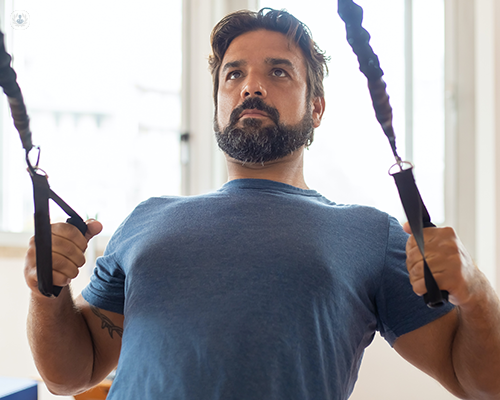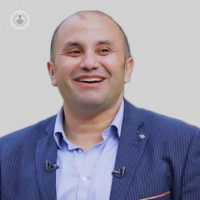Optimising Rehabilitation After Arm Surgery: Tips for a Quick Recovery (Part 2)
Written by:Although arm surgery can significantly impact a patient’s daily life, quick and effective rehabilitation can help minimise this effect. There are many proven programmes available, based on evidence, training and surgical techniques. Based on published evidence, surgeons follow unique protocols to ensure the most effective post-operative rehabilitation and quick recovery after surgery.
Professor Mohamed Imam is a distinguished consultant orthopaedic surgeon who specialises in upper limb surgery. Following on from the first part, Professor Imam offers an expert insight into how to overcome the common challenges faced during rehabilitation and how the use of wearable devices can support the recovery process, in this conclusion of a two-part series of articles on rehabilitation after arm surgery.

What are the common setbacks and challenges faced during arm surgery rehabilitation, and how can they be overcome?
Common setbacks and challenges faced during arm surgery rehabilitation include:
- Pain: Pain is a common setback during arm surgery rehabilitation, and can be caused by various factors, such as inflammation, scarring and muscle weakness. Pain management techniques like pain medication or nerve blocks can help overcome this challenge. Strengthening muscles after surgery can be painful, too, but as the rehabilitation progresses, the muscles continue to improve, and the pain subsides.
- Stiffness: Stiffness can occur when the arm has not been used for an extended period of time or when the range of motion exercises have not been performed regularly. Range of motion exercises and manual therapy techniques can help overcome this challenge.
- Weakness: Weakness can occur after arm surgery due to muscle atrophy, nerve damage or other factors. Strengthening exercises and progressive resistance training can help overcome this challenge.
- Limited range of motion: Limited range of motion can occur after arm surgery, and can impact the ability to perform daily activities. Range of motion exercises and manual therapy techniques can help overcome this challenge.
- Scarring: Scarring, which can occur after arm surgery, can impact range of motion and cause discomfort. Scar management techniques, such as massage, silicone sheeting and topical gels, can help overcome this challenge.
- Frustration: Frustration can occur when progress is slow, or the patient feels like they are not progressing. Evidence has shown that realistic expectations and working closely with the physiotherapist to develop a rehabilitation plan that is tailored to the patient's needs and goals, are important.
Overcoming these challenges requires effective pain management techniques, physical therapy, patient education and support. The physiotherapist can help to develop a rehabilitation plan that considers the patient's specific needs and goals, and help to ensure that the patient progresses steadily towards recovery.
How can incorporating technology and wearable devices aid in optimising rehabilitation after arm surgery?
Incorporating technology and wearable devices can aid in optimising rehabilitation after arm surgery by:
- Providing real-time feedback: Wearable devices and technology, such as physiotherapy apps and wearable sensors, can provide real-time feedback on the patient's rehabilitation progress, allowing the physiotherapist to monitor progress and make any necessary adjustments to the rehabilitation plan.
- Improving accuracy and consistency: Technology can help to improve rehabilitation exercises' accuracy and consistency, ensuring that the patient performs exercises correctly and progresses steadily towards their goals.
- Engaging patients: Incorporating technology and wearable devices can help to engage patients, and make rehabilitation more enjoyable and motivating.
- Monitoring progress remotely: Technology and wearable devices can allow the physiotherapist to monitor progress remotely, reducing the need for in-person visits and making rehabilitation more convenient for the patient.
- Providing virtual reality experiences: Virtual reality technology can provide patients with immersive experiences that can help to improve range of motion, reduce pain and increase motivation.
Incorporating technology and wearable devices into the rehabilitation process after arm surgery can provide various benefits, including real-time feedback, improved accuracy and consistency, engagement, remote monitoring, and virtual reality experiences. This can help to optimise rehabilitation and ensure that the patient is making steady progress towards their recovery goals.
In conclusion, quick and effective rehabilitation after arm surgery can help to restore the arm's range of motion, strength, and function, allowing the patient to return to normal activities as soon as possible. Incorporating technology and wearable devices, focusing on the range of motion and strengthening exercises, and overcoming common setbacks and challenges, can help to optimise rehabilitation and improve the outcome of the surgery. Patients should discuss their rehabilitation plan with their surgeon and physiotherapist to ensure a quick and successful recovery.
If you are going to start rehabilitation for arm surgery, do not hesitate to book an appointment with Professor Mohamed Imam via his Top Doctors profile today to discuss your case and receive expert advice and management.


